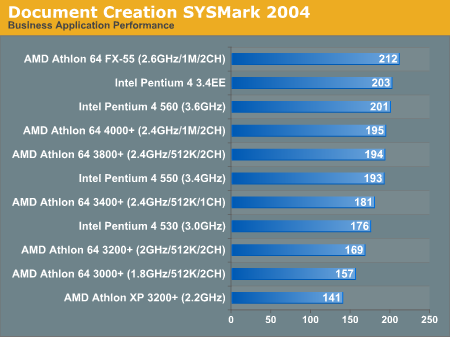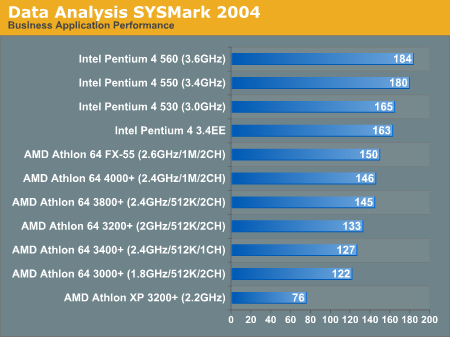AMD Athlon 64 4000+ & FX-55: A Thorough Investigation
by Anand Lal Shimpi on October 19, 2004 1:04 AM EST- Posted in
- CPUs
Business/General Use Performance
Business Winstone 2004
Business Winstone 2004 tests the following applications in various usage scenarios:
. Microsoft Access 2002
. Microsoft Excel 2002
. Microsoft FrontPage 2002
. Microsoft Outlook 2002
. Microsoft PowerPoint 2002
. Microsoft Project 2002
. Microsoft Word 2002
. Norton AntiVirus Professional Edition 2003
. WinZip 8.1
AMD has always dominated performance under business applications, which is why in the past they have always been known as a good CPU maker for office applications. Obviously with the K7 and K8 series of processors AMD changed the rules of the game a bit, offering top of the line performance in far more than just office applications. However, despite AMD's improvements in performance elsewhere, the Athlon 64 continues to hold on as the fastest processor for business applications.
Here we see that there is no performance difference between the three 2.4GHz parts, which is to be expected considering the relatively small datasets and correspondingly low bandwidth nature of business applications.
Even the entry level Athlon 64 3200+ is able to outperform Intel's top of the line Pentium 4 560 here. While Intel will argue that performance here doesn't matter, what does matter is that AMD is faster at a lower price point. Even the old Athlon XP 3200+ is able to offer performance similar to the Pentium 4 550.

Office Productivity SYSMark 2004
SYSMark's Office Productivity suite consists of three tests, the first of which is the Communication test. The Communication test consists of the following:
"The user receives an email in Outlook 2002 that contains a collection of documents in a zip file. The user reviews his email and updates his calendar while VirusScan 7.0 scans the system. The corporate web site is viewed in Internet Explorer 6.0. Finally, Internet Explorer is used to look at samples of the web pages and documents created during the scenario."
While the Athlon 64 FX-55 and 4000+ manage to land on top, it isn't by a huge margin. The FX-55 holds just under an 8% performance advantage over Intels Pentium 4 3.4EE. The Pentium 4 550 and Athlon 64 3800+ tie in the middle, while the 3400+ offers statistically similar performance.
What's interesting to note here is that the Athlon XP 3200+ manages to outperform, ever so slightly, the newer Athlon 64 3000+, thanks to a somewhat shorter pipeline and higher clock speed. What these results tell us is that the Communication test is much less dependent on the memory subsystem, rendering the on-die memory controller advantages of the Athlon 64 relatively useless. Our theories are confirmed by the fact that there's virtually no difference in performance in the single and dual channel memory configurations of the Athlon 64. There is, however, a boost in performance when going from a 512KB cache to a 1MB cache (3800+ -> 4000+), indicating that the datasets here are too big for a 512KB cache, but fit much better in a 1MB cache.
The Pentium 4 does relatively well here, with the Prescott based 90nm 560 offering similar performance to the Northwood based 130nm 3.4EE, with the higher clock speed able to make up for Prescott's other shortcomings.

The next test is Document Creation performance, which shows very little difference in drive performance between the contenders:
"The user edits the document using Word 2002. He transcribes an audio file into a document using Dragon NaturallySpeaking 6. Once the document has all the necessary pieces in place, the user changes it into a portable format for easy and secure distribution using Acrobat 5.0.5. The user creates a marketing presentation in PowerPoint 2002 and adds elements to a slide show template."
The inclusion of a speech recognition test as a part of this next benchmark immediately excludes the older generation of processors from being in the running for top performance spots. The lack of an on-die memory controller keeps the Athlon XP 3200+ at the end of the pack, while the more bandwidth friendly Pentium 4 and Athlon 64 platforms battle it out for the lead here.
The Athlon 64 FX-55 manages to secure a small 5% lead over the 3.4EE and the Pentium 4 560. It's not a noticeable performance lead in the real world, but it does stand on paper (or on web if you prefer). We once again see that there's no huge benefit to the 4000+'s 1MB L2 cache, but the dual channel configuration of our Socket-939 platforms clearly comes in handy, resulting in a 7% performance boost for the 3800+ over the single channel 3400+.

The final test in our Office Productivity suite is Data Analysis, which BAPCo describes as:
"The user opens a database using Access 2002 and runs some queries. A collection of documents are archived using WinZip 8.1. The queries' results are imported into a spreadsheet using Excel 2002 and are used to generate graphical charts."
Although not quite the enterprise level server database, MS Access does get used quite frequently in small to medium sized business environments to handle light database loads.
Here the Pentium 4s completely dominate, with the Prescott core truly extending the performance lead here. None of the AMD chips even stand a chance, not to mention the thrashing that the XP 3200+ gets. The Data Analysis tests do prove that despite the performance in other areas, there are a few pedestals that the Pentium 4 does continue to stand quite high upon.











89 Comments
View All Comments
coolme - Monday, January 10, 2005 - link
#85 yeah, but when comparing to Tom's Hardware review, it's totally off track... (Tom's is more believeble because there is pics of how he measured it and based on the fact that there is no way a A64 could handle 200+ watts)http://www6.tomshardware.com/cpu/20041115/pentium4...
how Tom tested it: http://www6.tomshardware.com/cpu/20041115/pentium4...
eight - Monday, December 27, 2004 - link
Has anyone information about A64 performance with Premiere Pro 1.5? I assume thet A64 does beat P4, but assumption is mother of... :)euanw - Tuesday, November 9, 2004 - link
#44Wesley,
I am very impressed by your articles. Can you inform me of the procedure you used to overclock the FX55? With the Neo2 board I am not clear on CPU vid and CPU voltage, what do they mean? When I change the multiplier to 13.5 my new PC reaches winXP and then reboots.
My setup is MSI K8N-Neo2-54G, FX-55, 2 x 512MB - OCZ EL DDR PC-3200 Platinum Rev2, Nvidia Quadro FX3000, 2x Seagate Barracuda 7200.7 120 GB, Matrox RTX-100 real time video editor, Antec TrueBlue 480W ATX-12V, BenQ DVD Dual DW1610, WinXP-SP2.
euanw - Tuesday, November 9, 2004 - link
#44Wesley,
Gioron - Sunday, October 24, 2004 - link
While I'm unsure of the exact method used in this review, I'm sure that there is no built-in power measurement devices on the motherboards and processors listed (unless its new and no one told me...) so its NOT just just a matter of installing software that can read a sensor thats already there (as in all the CPU temp monitors). This means it requires some hardware to measure the voltage and current flow to various components (or you can cheat a little and assume the voltage is constant and just measure current).Unfortunately, this is not as easy as it sounds, since isolating various components can be a problem. Its fairly easy to measure things like hard drive power useage since there is only one power connector going to it and its easy to access, so you measure the current on the 5v line and the current on the 12v line, and you're pretty much done. Things like CPUs, motherboards and graphics cards are a bit more difficult. On the newer graphics cards you can measure the power consumption from the additional molex connector, but in all likelyhood, the card will also draw a certain amount of power from the AGP slot power lines, and no one in their right mind is going to unsolder the AGP slot and raise it half an inch in an attempt to put a current sensor in line with the power leads. Thus, you need to rely on indirect means and educated guesses. You can measure the current going into the motherboard, but how much of that is going to the chipset, the CPU, the RAM and the graphics card? You can swap in a different CPU and see how it changes, but that won't give you absolute readings. You can try to remove the CPU and see what power the MB uses without one, but odds are it'll use more power when its actually interfacing with a CPU instead of beeping error codes at you.
Bottom line: There is no easy way to measure power consumption, and even dedicated hardware review sites have problems with it. Personally, I trust Anand far enough that I'm sure he didn't completely screw it up, and the numbers he has are probably close enough to the real thing. I'd forget about measuring power for myself.
xsilver - Friday, October 22, 2004 - link
Kinda late on the comments but..If anand or anybody can answer -- what is used to measure the "power consumption" software? or hardware? links? I would like to test this myselfthanks
Bakwetu - Friday, October 22, 2004 - link
Whoah, it's been a while since I checked out cpu reviews and I must say Amd has some impressive cpu:s nowadays. Even though I am budget oriented when it comes to buying hardare, I'd choose the 3400+ model before the 3200+, it's not all that much more expensive and seems to perform much bettert - Friday, October 22, 2004 - link
79uhuh.... and in a server type situation, how many raid arrays are ran off the chipset controllers? not many i would wager..
hell... u prolly have an independent fibre optic raid array :)
hardware, baby, hardware.
t.
knitecrow - Friday, October 22, 2004 - link
I always knew women were trouble when it comes to technology ;)screech - Thursday, October 21, 2004 - link
nice ones #79, 78. :)